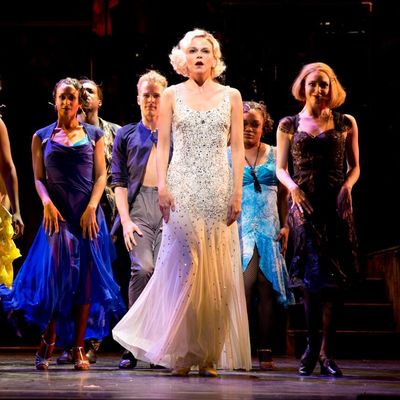
Are you Team Lippa or Team LaChiusa?
For theater types, the dueling musicals of The Wild Party — one by Andrew Lippa, one by Michael John LaChiusa, both somehow given their premieres in the spring of 2000 — provide an opportunity for personal branding and group identification that others may get from, say, The Hunger Games. Both derive from Joseph Moncure March’s seedy Jazz Age narrative poem about a gin-soaked debauch chez Queenie and Burrs, a vaudeville siren and her abusive lover. Both musicals use (to varying degrees) vaudeville itself as a framing device and a metaphor for the disjointed, sensation-oriented experiences that pass for their characters’ lives. And both musicals flopped, Lippa’s off Broadway and LaChiusa’s on, despite stellar casts and scores memorable enough to become quick cult items when recorded. But in almost every other way the two parties are entirely different, and for me the sensational mounting of Lippa’s version with which the “Encores! Off-Center” series is closing its third season is a fascinating opportunity to consider what those differences mean in the context of the 21st-century musical.
It would be hard to imagine a production, let alone one rehearsed and put together in only ten days, that made a better case for the material. This is not a thrown-together staging on a cheap, borrowed set; it is, somehow, a physically beautiful, thoroughly realized (by director Leigh Silverman), and fully choreographed (by Sonya Tayeh) account of a complicated story. (The lighting, by Mark Barton, is about the best I’ve ever experienced at Encores!, and so is the sound, by Leon Rothenberg.) It’s Broadway-ready; indeed, if extra money has been provided to achieve this level of polish, no doubt it’s in part because the casting suggests a potential transfer. Queenie is played as a kewpie-lipped Jean Harlow vamp by Sutton Foster, who brought the “Encores! Off-Center” Violet to Broadway last year, and Burrs by Steven Pasquale, now a TV star but one of the most thrilling bari-hunks in the business. The lesser known but just as fine Brandon Victor Dixon (Motown the Musical) is Queenie’s new love interest, Mr. Black, and Joaquina Kalukango, a recent Cleopatra at the Public, is Kate, the crucial fourth side of the romantic quadrilateral. All are jaw-droppingly good — as, in various other roles, is the ensemble of 15 — achieving without apparent strain a level of singing that has rarely been achieved in an Encores! production. I don’t just mean American Idol–style melismas and wails, though there’s plenty of that when appropriate. But the discipline with which the voice is deployed as a medium for establishing character, and the abandon with which it is used as a brute expression of conflict, turn numbers like Kate’s “Life of the Party” and Burrs’s “Let Me Drown” and the quartet “Poor Child” into reminders of what bravura pastiche writing can call forth in first-class singing actors.
I really have nothing to criticize about this production, except perhaps to say that along with A New Brain and Little Shop of Horrors earlier this summer it sets the bar unreasonably high for future Off-Center seasons. (The music direction alone, by Chris Fenwick, has been off the charts.) But the point of all this excellence is surely to let us see the work as clearly as possible, and in doing so this production may make you consider not so much what team you are on as why. Lippa’s work is more overtly entertaining than LaChiusa’s, as the series of showstoppers so effectively rendered here proves again. In many cases, though, these numbers come across as just that, numbers: separable entities only notionally connected to the story. (Lippa’s reshuffling of the running order, so that the title song, which used to come near the end of the first act, now comes at the start, only enhances this effect.) There are “specialty” numbers for each of the supporting characters, including the reliably hilarious “An Old-Fashioned Love Story” for the lesbian stripper Madelaine True (Miriam Shor) and “Two of a Kind” for the thuggish boxer Eddie and his tiny girlfriend Mae (Ryan Andes and Talene Monahon). You sense that in conceiving the score, Lippa was trying to make each song shine as an example of its type, rather than to excavate it (as LaChiusa seems to do) for character expressiveness. These are both valid approaches; in fact, Lippa, in writing a probing new final song for Queenie (“A Happy Ending” instead of the original’s “How Did We Come to This?”) seems to be having a Team LaChiusa moment. “A Happy Ending” (the title is ironic) is open-ended instead of self-sealing, troublingly unfamiliar instead of nostalgically reassuring: the kind of number that, being an exception in this score, may help explain why LaChiusa’s Wild Party is easier to love, Lippa’s easier to like.
But in a way, the various contrasts between the two works just point to a bigger, mutual problem: Both are somewhat labored attempts to transform decades-old material from one genre into another, and both do so using the forms of earlier styles of entertainment as their organizing principle. This is a kind of musical theater, with an undercurrent of insincerity, that was already considered moribund by the time Follies deconstructed it in 1971. It makes you wonder what, if anything, Encores! presentations decades from now will be able to offer as examples of forms pioneered at the beginning of our century. As good as the parties are, we need to find some new teams.
The Wild Party is at City Center through July 18.

